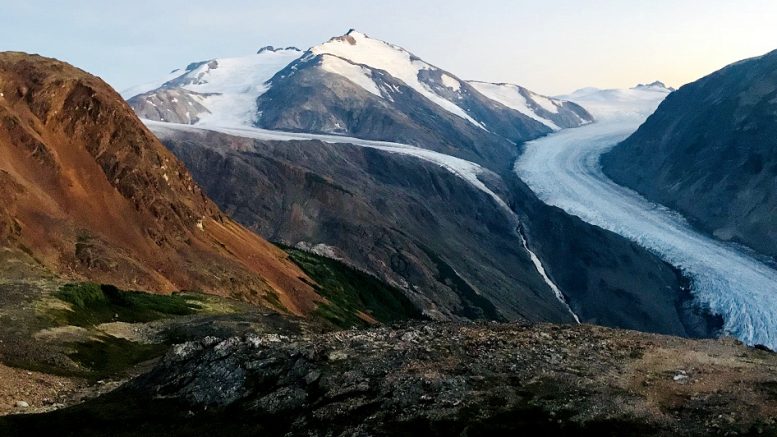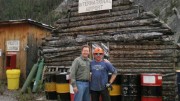STEWART, BRITISH COLUMBIA — Vancouver-based IDM Mining (TSXV: IDM; US-OTC: IDMMF) is steadily advancing its wholly owned Red Mountain gold project in northwestern British Columbia’s Golden Triangle region.
“We are about to have one of the few shovel-ready mines in Canada, and it’s going to do the one thing the mining business hasn’t lately — generate significant cash flow,” IDM president and CEO Robert McLeod tells The Northern Miner on a visit to the project.
Red Mountain stands between the Cambria Icefield and its largest outlet, the Bromley Glacier. From the nearby town of Stewart, it is a 10-minute helicopter ride.
Placer mining began in the valley below Red Mountain in the early 1900s, when prospectors were leading Stewart’s first wave of European settlement.
The area’s history is one McLeod, a third generation Stewart miner, knows well.
“IDM stands for Ian and Donald McLeod, two Stewart boys who did pretty well in life and mining,” McLeod says in reference to his late father and uncle.
Ian was a miner and pack horseman at a number of Golden Triangle mines before taking over his father’s hotel in Stewart. Donald is a member of the Canadian Mining Hall of Fame, who was known for his mining discoveries and developments throughout British Columbia.
Robert McLeod’s personal ties to the project go beyond his hometown: his career as an exploration geologist began at Red Mountain when he was working for Lac Minerals in the early 1990s.
Lac acquired Red Mountain in 1991, two years after gold-silver mineralization was found and three years after the first claim was staked. For the next five years, the company built a production-sized exploration adit and drilled 90,000 metres from both surface and underground.
McLeod left Red Mountain in 1995, shortly before Lac was bought out by Barrick Gold. From then until 2014, the project switched hands a few times, but stayed more or less dormant.
“It was a project I always had in the back of my mind,” McLeod says.
In 2014, he completed his return by forming IDM and buying Red Mountain from Seabridge Gold (TSX: SA; NYSE: SA).
Difficult junior-financing conditions at the time, caused by a drop in metal prices, kept a lid on activity for the first couple of years. But in 2016, when the markets turned around, IDM was one of the first juniors to raise capital.

The camp at IDM Mining’s Red Mountain gold project in northwest British Columbia. Photo by Colin Desmond.
Since then, it has spent $30 million advancing Red Mountain towards production and growing resources along the way.
In June, IDM tabled an updated resource estimate that incorporated trench and channel sampling, 30,000 metres of mostly underground drilling, and a refined geological model.
Resources at Red Mountain are now estimated at 2.8 million measured and indicated tonnes grading 7.91 grams gold per tonne and 22.75 grams silver per tonne for a contained 704,600 oz. gold and 2.03 million oz. silver, almost double the 381,000 oz. gold and 1.4 million oz. silver tallied in 2014.
The conversion of almost all the inferred resources in Red Mountain’s three mineralized zones — Marc, AV and JW — to measured and indicated was responsible for most of the most recent increase in resources.
Red Mountain’s mineralized zones consist of tabular, northwest-trending and moderately to steeply southwest-dipping, gold- and silver-bearing iron-sulphide stockworks. Pyrite is the dominant sulphide, with local pyrrhotite. The stockwork zones are developed within the Hillside porphyry, and, to a lesser extent, in rafts of sedimentary and volcaniclastic rocks.
Four kilometres southwest of those resources, rapid glacial retreat has opened up IDM’s most significant exploration upside in the Lost Valley.
When Robert McLeod was here in the 1990s, Lost Valley was submerged in ice connecting the Cambria Icefield with the Bromley Glacier’s northeastern flank.
IDM hopes it is the latest in a series of recent Golden Triangle discoveries revealed by rapidly melting glaciers, including Pretium Resources’ (TSX: PVG; NYSE: PVG) Valley of the Kings gold-silver deposit and Seabridge Gold’s Mitchell gold-molybdenum deposit.
In July, IDM reported surface sampling results from 51 panel samples collected on 1-metre intervals from Lost Valley’s Money Rock structure. The samples averaged 9.8 grams gold and 101.4 grams silver, including 2 metres averaging 13.4 grams gold and 1,531 grams silver. In total, trenching has exposed over 100 metres of strike length along the Money Rock structure.
IDM hopes to connect with the nearby Randell vein, where hand trench samples within a sub-cropping of quartz and sulphide veins have averaged 22.4 grams gold and 81.7 grams silver over a 9-metre channel.
Surface-exploration work will continue at Lost Valley, in addition to Red Mountain, as the company moves through the permitting process.
That process reached a milestone on Aug. 29, when British Columbia’s Environmental Assessment Office completed its review of IDM’s application for Red Mountain. It will now be referred to the provincial cabinet, who will provide a decision within 45 days.
The project is also subject to a concurrent federal environmental assessment, which IDM expects will conclude in late 2018 or early 2019.
An integral part of both reviews has been consultation with the Nisga’a, a First Nation located primarily in the nearby Nass River valley.
Red Mountain lies on Crown land within the Nass Wildlife Area, where the Nisga’a have fish and wildlife management rights set out in the Nisga’a Final Agreement, a land-claims settlement between the Nisga’a, provincial and federal governments signed in 1998.

Site visit participants examining the Lost Valley zone’s Money Rock structure at IDM Mining’s Red Mountain gold project in northwest British Columbia. Photo by Colin Desmond.
The McLeod name is by no means foreign to the Nisga’a. Aside from their roots in the area, McLeod’s father was Stewart mayor for 15 years and helped run the late Nisga’a politician Frank Arthur Calder’s campaign to British Columbia’s legislature. (Calder’s victorious 1969 lawsuit against British Columbia’s attorney general, which established that Aboriginal title exists within modern Canadian law for the first time, paved the way for the Nisga’a Final Agreement three decades later.)
“My father taught me to respect all people, but especially our First Nations neighbours here in northwest British Columbia,” McLeod says. “I’ve tried to incorporate those lessons as we work to develop what I believe is a very respectful, strong and positive partnership with the Nisga’a.”
McLeod’s vision for helping the Nisga’a build a mining culture — modelled on that of the nearby Tahltan Nation — is shared by Red Mountain camp manager and Nisga’a member Stephen Bolton.
“The forestry and fishery industries are in decline,” Bolton says. “The Nisga’a youth will grow up to be miners.”
McLeod hopes Bolton is one of many northern British Columbians who will benefit from a Red Mountain gold mine.
“When it comes time to hire, our first priority is people from Stewart and the Nass River valley,” he says. “It’s just the right thing to do.”
As The Northern Miner was leaving Red Mountain, IDM staff were preparing to host Nisga’a elders and government officials for a property visit. IDM’s impacts and benefits agreement (IBA) with the Nisga’a — currently in draft form — will be on the agenda. McLeod says he expects the IBA to be ratified by the band’s government sometime in the fourth quarter.
Ideally, IDM would begin Mines Act permitting early next year, with the Nisga’a IBA and federal and provincial environmental approvals in hand.
That would coincide with an updated feasibility study IDM expects to publish in the first quarter.
The 2017 feasibility study envisioned Red Mountain would produce 425,000 oz. gold and 1.2 million oz. silver over a 5.4-year mine life. It projected a $104-million post-tax net present value and a 32% internal rate of return, after $135 million in pre-production capital expenses and $67 million in sustaining capital expenses.
McLeod is optimistic the updated feasibility study will show improved economics, after June’s updated resource estimate and changes to Red Mountain’s engineering plans.
After Osisko Gold Royalties (TSX: OR; NYSE: OR) invested $15 million in IDM through a private placement in February 2017, it dispatched its in-house engineering team to Red Mountain to help IDM improve its engineering plans for the project.
That has included, first and foremost, optimizing the underground mining methods.
“If you want to learn how to mine underground, you go to Osisko,” McLeod says.
For the steeper-dipping orebodies, Osisko’s team has recommended a lower minimum longhole stoping angle, thereby increasing the amount of tonnes available for longhole stoping.
For the shallow-dipping tabular orebodies, they have recommended the recently developed Holloway method, which will require less underground development than the previously planned cut-and-fill method.
Osisko has also helped improve the ore processing, power and infrastructure plans at Red Mountain, McLeod says.
Within three months of publishing the updated feasibility study, IDM expects to solicit bids for a fixed-price engineering, procurement and construction contract that would help IDM offload the risk of delays and cost overruns to the engineering firm for a fixed fee in the contract price.
“It would dramatically decrease the execution risk,” McLeod says. “For the majority of capital costs, you obtain certainty. With this type of small, in-the-ground project, where the costs are relatively predictable, engineering companies can take on some risk and make some money if they operate efficiently. It’s a win-win situation.”
IDM’s ease in raising equity over the past few years has generated significant dilution, limiting the attraction of another large offering. McLeod is optimistic there are synergies to be found with other projects in the area.
“We are exploring lots of merger and acquisition opportunities,” McLeod. “We’re not going to raise a bunch more capital and dilute our shareholders. Once our permit is in hand, we’re going to have one of the few shovel-ready projects in Canada.”






Be the first to comment on "Site visit: IDM keen on Red Mountain in Golden Triangle"